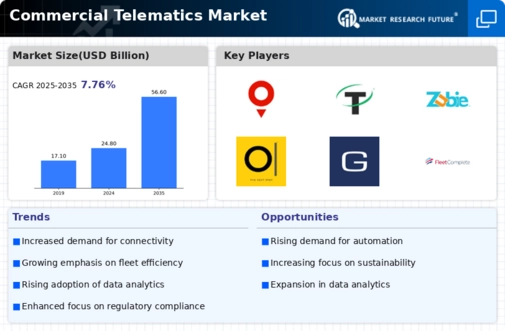Increased Focus on Cost Reduction
The relentless pursuit of cost reduction is a significant driver of the Commercial Telematics Market. Companies are increasingly recognizing the potential of telematics solutions to lower operational costs through improved efficiency and resource management. By utilizing telematics data, businesses can identify inefficiencies, optimize routes, and reduce fuel consumption. Reports indicate that companies implementing telematics can achieve fuel savings of up to 15%, which translates into substantial financial benefits. Furthermore, the ability to monitor vehicle maintenance needs proactively can prevent costly repairs and downtime. As organizations strive to enhance their bottom line, the adoption of telematics solutions is likely to accelerate, further propelling the growth of the Commercial Telematics Market.
Growing Importance of Data Analytics
The growing importance of data analytics is transforming the Commercial Telematics Market. As telematics systems generate vast amounts of data, businesses are increasingly leveraging analytics to derive actionable insights. This trend is evident in the rising demand for advanced analytics tools that can process and interpret telematics data effectively. Companies are utilizing these insights to enhance decision-making, improve operational efficiency, and develop predictive maintenance strategies. The market for telematics analytics solutions is projected to witness substantial growth, with estimates suggesting a compound annual growth rate of over 20% in the coming years. This emphasis on data-driven decision-making is likely to be a key factor in the ongoing evolution of the Commercial Telematics Market.
Advancements in Connectivity Technologies
Advancements in connectivity technologies are playing a crucial role in shaping the Commercial Telematics Market. The proliferation of 4G and 5G networks is enabling real-time data transmission, which enhances the functionality of telematics systems. This connectivity allows for more accurate tracking, improved communication between vehicles, and better integration with other technologies such as the Internet of Things (IoT). As a result, businesses are increasingly adopting telematics solutions that leverage these advancements to gain competitive advantages. The market for connected vehicles is expected to grow significantly, with estimates suggesting that connected vehicle sales could reach over 30 million units annually by 2027. This trend indicates a robust growth trajectory for the Commercial Telematics Market.
Regulatory Compliance and Safety Standards
Regulatory compliance and safety standards are increasingly influencing the Commercial Telematics Market. Governments worldwide are implementing stringent regulations aimed at enhancing road safety and reducing accidents. For instance, mandates for electronic logging devices (ELDs) in commercial vehicles have propelled the adoption of telematics solutions. The market for ELDs alone is anticipated to reach several billion dollars by 2026, reflecting the growing emphasis on compliance. Additionally, telematics systems that monitor driver behavior and vehicle conditions can help companies adhere to safety regulations, thereby minimizing liability and insurance costs. As such, the need for compliance with these regulations is likely to drive the demand for telematics solutions in the commercial sector.
Rising Demand for Fleet Management Solutions
The increasing need for efficient fleet management solutions is a primary driver of the Commercial Telematics Market. Companies are seeking to optimize their operations, reduce costs, and enhance productivity. According to recent data, the fleet management segment is projected to grow at a compound annual growth rate of approximately 15% over the next five years. This growth is attributed to the rising fuel prices and the need for real-time tracking of vehicles. As businesses strive to improve their logistics and supply chain management, the demand for telematics solutions that provide insights into vehicle performance and driver behavior is likely to surge. Consequently, this trend is expected to significantly contribute to the expansion of the Commercial Telematics Market.


















Leave a Comment